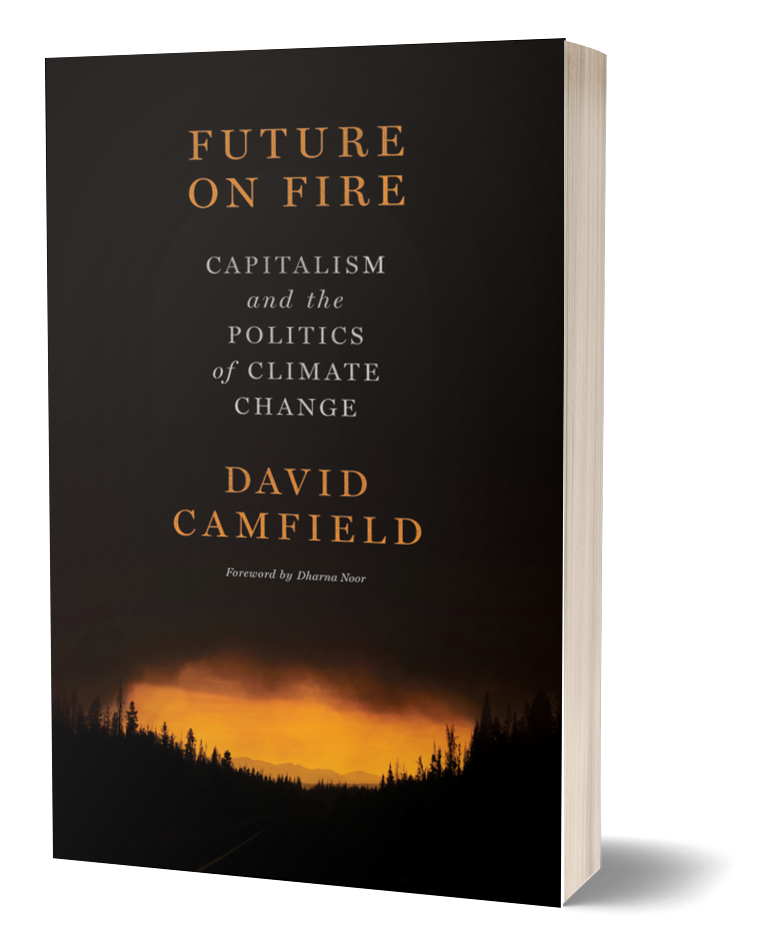By Taisie Tsikas
RS21
April 24th, 2023
David Camfield’s Future on Fire argues that only mass movements can build the power needed to confront the climate crisis and win a just transition. Taisie Tsikas reviews.
Future on Fire opens with an excellent overview of the realities of climate breakdown, and emphasises a key point: ‘How a society is organized is fundamental to how climate change affects people.’ Capitalist firms’ drive for profit is the cause of uncontrolled emissions, and it is the structure of class societies that determines the unequal impact of climate breakdown. The response must be to fight for a just transition: cut energy consumption in the Global North, stop fossil fuel production, and bring in reforms that reduce injustice – ‘a minimum emergency program.’
The next chapter explains why businesses and mainstream political parties won’t deliver the changes needed despite their pledges, targets and agreements. Businesses are operating in a ‘competitive, expansionary, ever-faster logic of profit’ that punishes deviations from whatever is the most profitable. The state is not a neutral instrument — instead it works for the various needs of the ruling class globally.
Having set the stage, Camfield makes his central argument: ‘only mass social movements have the power to win measures for a just transition and other reforms that challenge the priority of profit.’ A mass social movement is ‘large numbers of people acting together … directly intervening to change society … collective action … organizing … sustained … from many sectors of the population.’ Movements must force action from the state, but the point is to build up power to make that happen, not just back up radical politicians. The last chapters argue against all-or-nothing thinking that leads to climate action at any cost being prioritised over socially just outcomes, and put forward a vision for ecosocialism as a society ‘organized to meet human needs while maintaining a non-ecocidal relationship with the rest of nature.’
The point that mass movements are the only way to confront climate breakdown is not limited to the climate movement in a narrow sense. Camfield points to the gilets jaunes, the women’s strikes, the pension fight in France and Black Lives Matter, as well as climate struggles like the school strikes, Extinction Rebellion, and the fight against the Dakota Access Pipeline. The book is a clear call for a convergence of movements and for raising climate demands as part of wider struggles against exploitation and oppression.
Future on Fire comes in at just 77 pages, suited to its intended purpose as a movement intervention, but that does inevitably mean some arguments only get sketched out briefly. I think the focus is generally right, but a few things came across as incomplete. Degrowth only explicitly appears once and is spuriously linked to ecofascism, without an explanation of left degrowth arguments, even though the book argues for the principle of private sufficiency and public luxury. The climate politics of the present-day Right generally don’t appear. Camfield condemns turning to sabotage and vandalism where this is unconnected from movement-building, distinguishing this from ‘acts of sabotage carried out openly by large numbers of people [which] are a form of mass direct action.’ The distinction makes some sense but is made too neatly, counterposing elements that in practice don’t necessarily clash, and it isn’t clear who falls on which side of the divide.
The emphasis on arguing against sabotage tactics seems like a missed opportunity given that the climate movement in recent years has many excellent cases of integrating sabotage or blockades into mass resistance. There is a lot to learn from these experiences. As we saw in Lützerath, tens of thousands of people came to occupy the area while smaller groups took riskier actions like blocking tunnels. Camfield makes a generalisation that sabotage by small groups doesn’t serve ‘the goal of making states phase out fossil fuels’ but the point of these actions is generally to stop a particular fossil fuel project, not change policy. However, his main point stands: actions must aim to draw in more people.
The primary argument of the book is that the ‘unique power of mass social movements means that people who want to see at least the emergency measures needed to launch a just transition should unite around climate justice politics that focus our energies on movement building.’ But it isn’t exactly a handbook: ‘There are no recipes for building mass social movements and winning victories.’
In an essay on the possibility/necessity of climate revolution, Andreas Malm poses the question: ‘Who shall execute it?’ Camfield rightly says to look to ‘where exploited and oppressed people are in motion.’ But given that the causes and the impacts of climate breakdown are so unevenly distributed, is it likely that a mass movement will take on climate breakdown as its primary focus? Who do those movements need onside to win, and what must they fight for first? What kinds of international organising will be needed? What is the role of the existing climate movement in all this? In the words of Colin Barker: ‘The question, who is involved, and how, is of vital significance if the potential impact of a protest wave is to be assessed.’ The coalitional politics of solidarity and just transition that Future on Fire envisages is clearly the right orientation, but the next task is to work through how to apply that to the terrain of the climate crisis.






